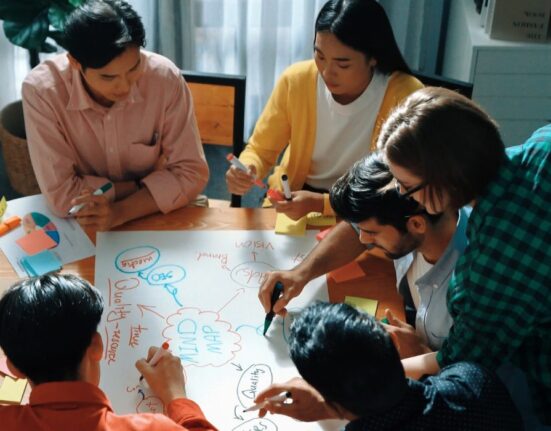When a child steps out of their home and the loving, protective arms of their parents into the halls of an educational institution, they enter a brand new world. They are introduced to newer environments, people, cultures and more. A school becomes their stepping stone into the eventual entry into the real and vast world. Children are expected to gather knowledge and foster connections. As they grow, they realise that not each one of their peers or fellow students is truly the same as them, and become aware of human differences. These differences add to the schooling experience, helping them not only become aware of but also appreciate diversity.
As schools hold the mirror up to society, reflecting human differences and divisions, they also uphold the vital responsibility of teaching students to accept these differences. While most efforts in classrooms only focus on identifying differences and spreading awareness, they rarely teach acceptance and inclusion. The journey from awareness to acceptance includes important virtues of respect, empathy, kindness and more. It not only shapes how children view others but also themselves.
Read More: When School Doesn’t Feel Safe: The Real Impact of Microaggressions
Understanding Human Differences in Schools
No two humans are the same. Differences arise in multiple forms, and multiple branches of psychology have dedicated efforts to not only understand but also quantify these human differences in varied settings. Tyler (1947) suggested “Measurable differences have been shown to exist in physical size and shape, physiological functions, motor capacities, intelligence, achievements and knowledge, interests, attitude and personality traits.” This suggests that the facets for differences to arise are multiple, ranging from physical and overt to psychological and covert.
In efforts to understand the different dimensions of individual human differences in education settings, Savita (2021) suggested the presence of the following dimensions:
1. Physiological Differences
- Physical Differences
- Motor Ability Differences
2. Mental Differences
- Intelligence Differences
- Achievements Differences
- Attitude Differences
- Special Abilities Differences
3. Emotional Differences
- Emotional Differences
- Interest Differences
- Attitude Differences
4. Social Differences
- Social and Cultural Differences
- Ideals, Values and Morality Differences
- Racial and National Differences
- Self Concept Differences
From Awareness to Acceptance: Why It Matters Acceptance Matters
Most efforts at the school level are focused on spreading awareness among children regarding differences among their peers and humans in general. However, without the virtue of acceptance, most of these efforts are aimed at building awareness that allows students to identify differences and use them as grounds for exclusion. Acceptance, on the other hand, creates a sense of belonging for all. This helps create that elusive sense of diversity that is so helpful in the psychological growth of children.
Read More: Effective Bullying Interventions in Schools
1. Maslow’s theory in school settings
Abraham Maslow’s theory of Motivation also suggests the importance of acceptance in an individual’s life (McLeod, 2025). One’s journey towards self-actualisation begins with basic needs and safety, but also requires a certain sense of love and belonging. This feeling of belonging, especially for children, must also be found in classroom settings, which can only be fostered when students start to accept individual differences. The lack of acceptance in a classroom can lead to the development of social evils such as stigma, prejudice, discrimination and stereotypes.
Read More: The Four Perspectives That Shape Human Motivation
2. Consequences of Lack of Acceptance: Stigma, prejudice, discrimination
The presence of acceptance also creates a profound sense of diversity within the classroom setting, allowing students to understand not only their roots but also other cultures and identities. This allows them to become more empathetic, open-minded and confident, all while feeling a greater sense of safety (The Importance of Multicultural Education – School of Education, n.d.). Simultaneously, an inclusive classroom that provides space for children and their differences has proven to increase and improve critical thinking (Gurin et al., 2002). Research also suggests that acceptance and inclusivity within the classroom are associated with higher overall achievements for both minority and majority group members (Bowman, 2010).
How Schools Can Foster Acceptance
Since schools are the first stepping stones for children into the real world, where they learn how to interact with others and develop socially, schools find themselves in a hybrid role of acting as an effective agent to shape the attitudes of children towards differences among people. That includes spreading awareness and sensing acceptance of those differences in the child-inclusion, respect, empathy, and kindness. The actions taken by those in authority, trusted teachers, administrators, and school counsellors, help children accept differences.
The journey from awareness to acceptance in schools requires more than simple campaigns and policies, but rather intentional psychological approaches that will help integrate diversity as a daily practice into the lives of children. Various research in education and developmental psychology has highlighted different strategies that can be used during school life to foster a sense of acceptance for individual differences. They are:
1. Building Emotional Intelligence: Social-emotional learning
Acceptance begins and is actually nurtured through emotional intelligence that enables the child to have some sense of emotional awareness, probable forms of expression, and even the capacity for empathy. Emotional intelligence becomes the language through which the students appreciate their own values and the views of others, thus ensuring a fertile ground for acceptance. Social-emotional learning will greatly benefit children as it focuses on knowledge, skills, and attitudes towards forming a well-rounded identity, achieving goals, and feeling empathy for others, building positive relationships, making responsible decisions and managing emotions (Fundamentals of SEL – CASEL, 2024).
Read More: How Can You Be an Expert With Social-Emotional Learning?
2. Group Projects: Encouraging interaction across diverse groups
Group projects can be a wonderful medium for students to step out of their friend groups and interact with others in their class or from different groups. Drawing from psychologist Gordon Allport’s contact hypothesis, it becomes clear that under the right conditions, group projects can be essential in fostering acceptance amongst students. The contact hypothesis suggests that contact between in-group and out-group members occurs under the conditions of equal status, common objectives and institutional support can foster respect and break down stereotypes (McLeod, 2023).
3. Storytelling: Using narratives to humanise differences
Children have budding imaginations and often rely on storytelling as a medium of information regarding the real world. Using narrative psychology and storytelling to transform and shape attitudes towards acceptance can be extremely beneficial. Incorporating literature, films or narratives which highlight diversity, different experiences, and foster a sense of acceptance towards these differences will reduce stigma and increase normalisation (Dunn & Cherup, 2021). It also creates space for individuals to share their experiences and humanise their differences.
Read More: How Does Storytelling Transform Mental Health?
4. Inclusive Language: Respectful and non-discriminatory communication
Language is the only mode of communication and must be used to make all individuals feel accepted. Teachers can take efforts to address stereotypes and avoid any discriminatory language that may hurt a student’s identity. They can be the models for children to learn from as they incorporate inclusive language into their communication. Inclusive language will include respect for all cultural differences and even making room for errors.
5. Diverse Curriculum: Integrating multicultural perspectives
Diversity should not just be a one-time campaign or a policy that is forgotten about, but rather ingrained into the curriculum being taught to the students throughout the year. By integrating diversity in all its forms through the curriculum in various subjects, such as literature, history, science, etc, the students will learn about different cultures and individuals who differ from themselves. It will provide a comprehensive view of the world and teach them to appreciate differences (College of Education, 2024).
6. Peer Support: Mentoring, buddy systems, and inclusivity clubs
Student-led initiatives like peer mentoring, buddy systems, or inclusivity clubs ultimately ensure that children become active participants in creating respect for everyone. Acceptance, receiving support from within the student body, forms stronger bonds amongst the community while lessening the dependence on outside enforcement.
7. Training Pedagogues: Teacher development to address biases
Teachers should look into their biases and model acceptance. Professional development towards building more accepting attitudes in teachers will equip the students in the class with a similar nature as well. Efforts towards cultural sensitivity while keeping unconscious biases in check can be very beneficial.
Conclusion: Moving Beyond Awareness
When schools stop at awareness, they fail to honour individual differences and even stunt the holistic development of students. Acceptance is what truly transforms a school environment, without which awareness becomes superficial. Since schools play a vital role in the development of children, they hold great power and responsibility to foster acceptance of individual differences within them. These differences can range from physical and intellectual differences to cultural or identity differences, but all differences need to be accounted for. By opting for various psychologically based approaches and inclusive practices, educators and schools can take steps that help students navigate the journey from simply recognising diversity to actively appreciating it.
FAQs
1. How does awareness differ from acceptance?
Awareness and acceptance are vastly different. Awareness just means recognising that certain differences exist and becoming aware of these differences. On the other hand, acceptance involves embracing and respecting known differences as well as appreciating them in efforts to move towards the inclusivity of diversity.
2. How can the lack of acceptance impact students?
The lack of acceptance can manifest as exclusion, which can lead to great levels of loneliness, anxiety, depression, lower self-esteem, and disinterest in learning. It can even lead to greater social evils, such as bullying. In the long term, a lack of acceptance in the school environment will harm the child’s self-concept and their confidence levels.
3. Are awareness campaigns not enough?
Awareness campaigns are extremely important and must be continued in the school environment. However, they fall short in building acceptance as they solely focus on awareness. While awareness is the first step towards acceptance, it cannot be the only step that is taken.
References +
Bowman, N. A. (2010). College Diversity Experiences and Cognitive Development: A Meta-Analysis. Review of Educational Research, 80(1), 4–33. https://doi.org/10.3102/0034654309352495
College of Education. (2024, April 12). Nine Powerful Ways to Promote Inclusion in the Classroom. College of Education. https://education.illinois.edu/about/news-events/news/article/2024/04/12/nine-powerful-ways-to-promote-inclusion-in-the-classroom
Dunn, T. M., & Cherup, S. (2021). Storytelling and Success: How Storytelling Can Be Used to Promote Diversity, Cross-Cultural Understanding, and Confidence in the Classroom. Journal of Education, 203(3), 690–699. https://doi.org/10.1177/00220574211032309
Fundamentals of SEL – CASEL. (2024, November 27). CASEL. https://casel.org/fundamentals-of-sel/
Gurin, P., Dey, E., Hurtado, S., & Gurin, G. (2002). Diversity and Higher Education: Theory and Impact on Educational Outcomes. Harvard Educational Review, 72(3), 330–367. https://doi.org/10.17763/haer.72.3.01151786u134n051
Mcleod, S. (2025). Maslow’s Hierarchy of Needs. Simply Psychology. https://www.simplypsychology.org/maslow.html
McLeod, S., PhD. (2023). Allport’s Intergroup Contact Hypothesis: Its History and Influence. Simply Psychology. https://www.simplypsychology.org/contact-hypothesis.html
Savita, K. (2021). Individual Differences in the Classroom : Importance and Utilisation. ResearchGate. https://www.researchgate.net/publication/356527983_Individual_Differences_in_Classroom_Importance_and_Utilization
The Importance of Multicultural Education – School of Education. (n.d.). School of Education. https://drexel.edu/soe/resources/student-teaching/advice/importance-of-cultural-diversity-in-classroom/
Tyler, L. E. (1947). Nature and extent of measurable differences. In The Psychology of Human Differences (pp. 17–44). https://doi.org/10.1037/11271-002













Leave feedback about this